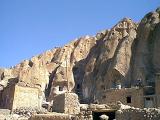
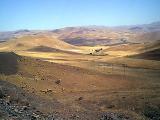
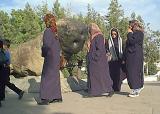
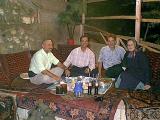
|
With our guide Machmat and our driver Hassan we drive to Tabriz, a wealthy city in the northern part of Iran. The wealth is indeed visible from the myriads of jewelry stores in the bazaar. In Iran, we have to be dressed according to the strict dress codes imposed by the Islamic law: a veil covering Petra's hair, a long coat, long trousers and long sleeved skirts. Not an easy task for a foreigner regarding the heat in the summer, nevertheless we give our best and go for a shopping tour of the appropriate pieces of clothes on the bazaar of Tabriz.
People stare at us everywhere we go; foreigners of Western European countries are a rarity here. Amazingly, we (mostly Marco) are addressed by young Iranian girls, who want to chat with us and even invite us to their home. However, we have a well-organized and planned program that does not allow us any private visits as our guide tells us.
Visible in every hotel and store are the pictures of Ayatollah Khomenei, the leader of the Islamic revolution, the face of Khatami, current president, and Khamenei, currently Prime Minister. Life in Tabriz is very organized, streets are clean, and people are friendly and smiling. We are pleasantly surprised by the meals, which, however, come only in a few variations throughout our journey: chicken or beef, rice, barley soup, yogurt and salad. As for the drinks, there is water, Fanta and Cola in all variations, and Ayran, a sour yogurt beverage, which has a very particular taste.
We visit a further cave village, Kandovan, which is similarly to the settlements we had already seen in Kapadokia. Kandovan, however, is still inhabited, and local farmers breed goats and sheep. The donkey is omnipresent as sole mean of transportation. Naturally, with our visit, we draw the attendance again of all the local people, above all the children that surround us everywhere. Trying to take pictures of people, we learn quickly, that men are forbidden to take pictures of women and so Petra has to take on the job.
There are many rules that make life between man and women quite different. Schools, baths, beaches, mosques, and some public institutions are separate indeed. Even during the wedding, man and women celebrate in separate rooms. From now on, our rooms in the hotels consist of two separate beds, too! Life of women, otherwise, seems very modern. They are allowed to work and move freely, they occupy high positions in companies and the government. The only (there are certainly more) difference to their Western counterparts seems to be their way of dressing: wrapped in the black Chaddor or a veil in order to escape from the view of other men.
The bazaars are mainly filled with jewelry and perfume shops. In the Iranian tradition, the love of a man for a woman is measured in grams of gold and the possession of expensive perfumes. Not a cheap affair for a man.
As we experience later, living together in a family is strictly regulated and
strongly shaped by religious thoughts. The religion plays an important role in Iran, of which 98% are Shiites. Shiites are less fanatic than the Sunnites. To our delight, as our hotel invariably is close to several mosques, the muezzin calls only three times a day (instead of five times as in Sunnite Turkey), and we can sleep calmly. God and his prophet Allah are present everywhere, and even all restaurant menu cards and hotel room instructions start with the famous 'In the name of God'.
In Sanandaj, our first stop after Tabriz, and capital of the province Kurdistan,
we seek to experience another form of extreme religious way of life: dances of Dervishes. By choosing an extremely hard way of life and suffering from hard exercises (sometimes by sleeping on a needle bed and walking on cut glasses), the-wipe feel particularly close to God. Their dances are a kind of religious exercise practiced in private temples. We finally find a Dervish, but he doesn't dance and try five other places where Dervishes are supposed to dance that night, without success, however. In the name of God.
From Sanandaj through Hamadan, which was built on the remnants of an old king residence, we drive to Isfahan, the city of the carpets. On the way we meet Nomadic people (Lori) with their pitch-black tent village installed in the proximity of our road. It is comfortably warm here in the high land in the summer. In wintertime, they move again south to the coast, where temperatures are unbearable in summer. Their main income comes from breeding goats and sheep and from the fabrication of carpets and other wool and leather products. As we learn, they have also become modern and now use trucks to move their property and livestock. The nomads are also exempt from the strict Islamic dressing rules and use their colorful and light wool clothing instead. In the name of God.
|
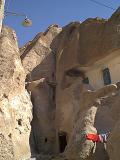
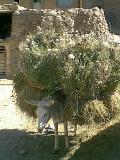
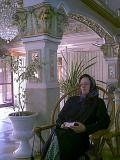
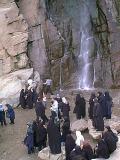
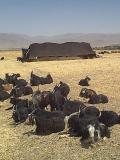
|